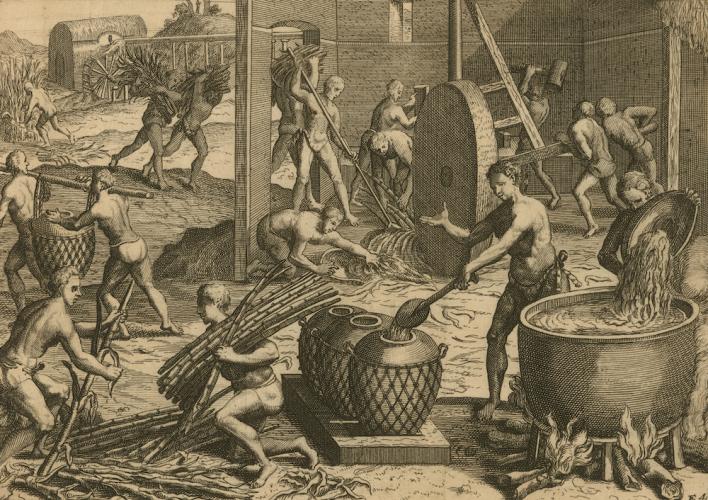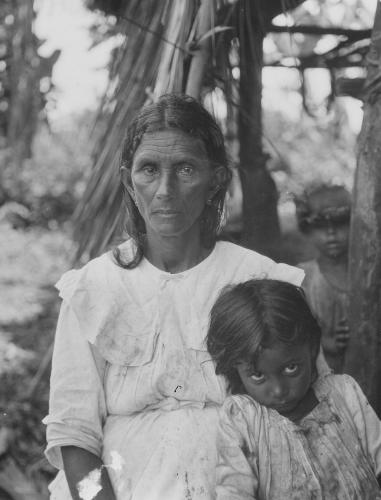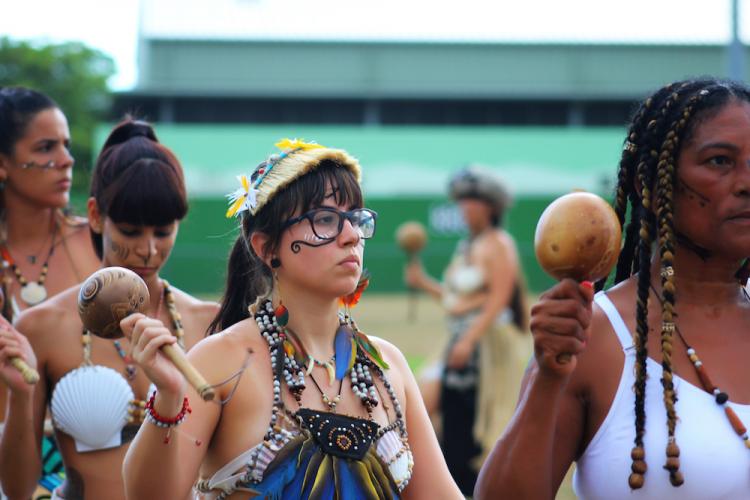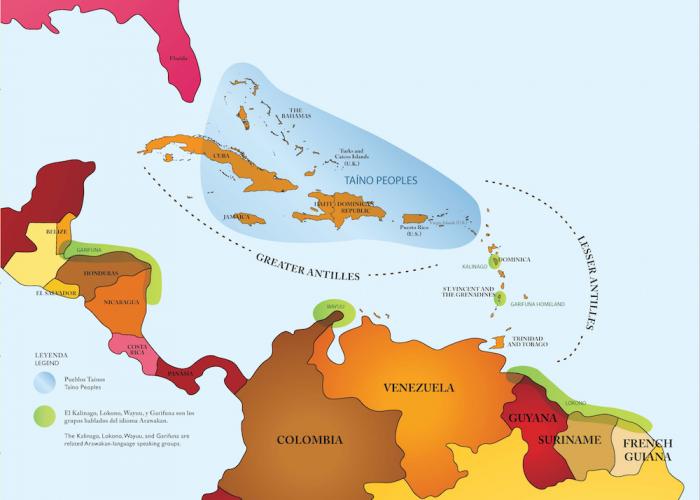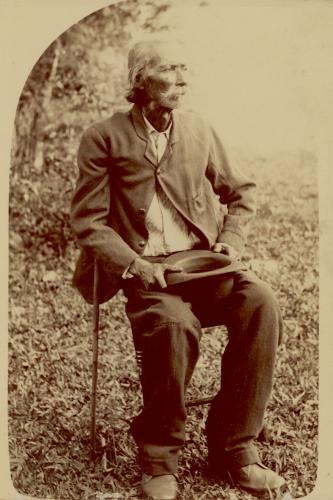No exhibition has actually addressed the topic of the survival of Native peoples in the Caribbean after 1492. The Native peoples of the region, represented by the durable elements of their material culture, are contained in museums within the pre-colonial moment. To frame an exhibit that emphasizes the survival and contemporary vitality of these indigenous peoples and their legacy is an intimidating task. But such is the upcoming Taíno: Native Heritage and Identity in the Caribbean, now under preparation for the National Museum of the American Indian – Smithsonian in New York City.
The objects that are generally considered to be the most emblematic of the Caribbean’s Native heritage are its archeological artifacts. These form a dialogue with the Native symbols and drawings in caverns and on rocks best known by locals across the region. They fill the Caribbean’s national museums and private collections. They contribute to regional visual imaginaries (like image banks for tattoos) and provide work for artisans who create crafts for tourists and masterful fakes for unknowing collectors. They have been deployed as symbols of resistance to colonialism and imperialism, but also to consolidate popular understanding of national identities.
For many audiences who consider these artifacts as part of their heritage, they arouse powerful questions about ancestry and invoke a sense of unresolved history regarding the colonial encounter between European, African, Indigenous and other peoples in the Caribbean.
In another lifetime – 2008 – I first approached the archeological Native American collections at the Smithsonian’s American Indian and Natural History museums with an interest in the history of the collections themselves. How were these artifacts first collected, and how did they end up at the Smithsonian? What were the political contexts, the ideologies behind collecting and the market forces at hand? About the time I was poking around collections, I heard someone in the Smithsonian leadership talk about the Taíno movement in Puerto Rico, and I thought to myself, “How’s that possible? Indians in Puerto Rico are extinct.”
The Taíno Movement
I didn’t imagine that in 2018 I would be opening an exhibit, not only about indigenous legacies in the Spanish-speaking Caribbean, but about the Taíno movement. Legacy doesn’t raise hackles – it’s a palatable topic and doesn’t offend the official narrative which holds that Native American survival (indio in this context) in the Great Antilles was impossible after colonization.
On the other hand, the Taíno movement, a declaration of Native survival through mestizaje (genetic and cultural mixing over time), reclamation and revival, was an intimidating topic for me as an exhibit developer and curator to tackle. This movement involves the descendants of Native peoples of the Spanish-speaking Caribbean and its U.S. diaspora, uniting under the label Taíno. It has emerged since the 1970s. Its participants are organized in diverse groups, informed by different, though often overlapping, social agendas and ideologies. They network and exchange information at in-person events including powwows and spiritual retreats and through online platforms such as Facebook. They are also a no-nonsense community that has been the subject of antagonistic scrutiny by some scholars who contest contemporary Taínos’ claim on indigenous identity.
With time I realized that despite the sensitivity of this topic, which clashes with the sensibilities and historical frameworks of some people inside and outside this movement, information for making sense of Native heritage is something for which the public, especially Latino audiences, are hungry.
Indigenous peoples of the Caribbean never have much of historical presence past 1550, by which point, most narratives consider Native peoples to be so few in number, especially in comparison to the increasing enslaved African workforce, that they cease to exist. The paper archives of the countryside and backwoods do not exist. Where Native presence does persist is in the repertoire and archive of popular memory, family histories, folk stories, regional lore and as living spirits in Caribbean religious traditions.
One thing to remember about the Caribbean, even in seemingly more culturally homogenous areas like Cuba, the Dominican Republic and Puerto Rico, is that despite its size it contains lots of diversity. This variety is complicated by creolization, which is the intricate process of cultural changes and exchanges – in all directions – over time, and by micro-regional differences. The colonial economies, labor practices and settlement patterns of the islands were varied and changed over time. Spanish control and presence was both real in the force of its genocide, and also symbolic in its capacity to sustain control and effectively settle and exploit. As an example, in Hispaniola (today Haiti and the Dominican Republic), four Native villages were discovered on the northern coast in 1556 during a period in which the island’s dwindling Native peoples had presumably all been counted by the official censuses.
Surviving 1492
The post-1492 survival of Native people, identity and culture in the region might be understood through overlapping forms of social positioning such as economic integration without too much intermarriage, isolation from the colonial order (going “off the grid”) and intermarriage. On the eastern side of Cuba, scholars are increasingly finding evidence in records and archeology of Native peoples and their neighborhoods integrated into the local colonial economy, in occupations such as ranching or pottery-making. Maroon communities formed by Africans and Native peoples escaping slavery were intentionally isolated from colonial authority; the memory of Native ancestors is still alive and honored in surviving Jamaican maroon communities. Similarly, there is evidence for the movement of Native peoples from the Greater Antilles to the Lesser Antilles and to Arawakan-language speaking areas of South America during the violence, epidemics and rampant enslavement of the early colonial period.
Intermarriage, politely put, refers to the genetic and cultural exchanges between Native, African and European peoples. The outcome of intermarriage – mixedness (mestizaje) is traditionally thought of as the end of the road for cultural Indianness. The Taíno movement, not unlike aspects of the Chicano movement, says just the opposite, that mixed race, descendants of indios have a right to reclaim and reconstruct this heritage, and that it is integral to their sense of spiritual and cultural wholeness.
Finding the Native peoples in the archives of the Dominican Republic and Puerto Rico requires serious academic inquiry. In the Dominican Republic regions like San Juan de la Maguana contain multi-layered Native histories that have spiritual dimensions like the invocation of the venerated chieftainess Anacaona (hanged by Spanish colonizers in the early colonial period). While some Dominican or Puerto Rican towns or areas are associated with the resettlement of particular Native communities (like the followers of Enriquillo or Natives from Mona Island), most of the family stories of Taíno movement participants situate their indio identity in the countryside. These accounts often describe somewhat isolated family homesteads relying largely on what they farmed or gathered from the surrounding forest for food, housing materials and domestic objects.
It merits restating that the social history of the countryside or back-country was usually only of superficial documentary interest to European travelers. It didn’t emerge as a topic in national Caribbean histories in the 20th century or was usually perceived through particular lenses like Marxism, Afrodiasporic Studies or Women’s Studies, which generally did not consider indigeneity. In the Dominican Republic and Puerto Rico, it is difficult to find textual documentation of Native communities or family groups. Despite increasing finds of Taíno genealogists which include church and civil records indicating ancestors’ race as india/o, this is still an emerging area of inquiry which requires further mapping of family groups and which correlates with local histories.
While in eastern Cuba researchers have been increasingly successful in uncovering and presenting the evidence of Native survival within Spanish colonial society into the present, I wonder how much of this history can really be recovered through archival and archeological research. So much of it unfolded outside the realm of documentation. I can only imagine what the Greater Antilles offered socially for the mixed race, Native and African peoples “left behind” on the islands by the bulk of Spanish settlers who moved onto minerally richer lands in Mexico, Peru and elsewhere on the mainland.
For about 200 years the Spanish authorities ignored the hinterlands of the islands (and their people), which had freedom from racialized control and labor/resource exploitations. The added bonus was that new forms of protein, like pigs and cows, offered better odds of survival in the remote interior into which escaping peoples like Natives, enslaved Africans and European outcasts retreated. Unfortunately, this is a critical period in history (perhaps outside of history) for which we have few tantalizing glimpses, such as physician Dr. Hans Sloan’s 1725 account of British Jamaica that describes the gardens and plant knowledge of the Natives farmers and hunters who had been integrated into colonial society. It should be noted that Native peoples from neighboring regions of the Caribbean were also enslaved and resettled in the Greater Antilles – such as the indigenous Jamaicans that formed new communities with African maroons, they too are ancestors and are part of the Taíno story.
Framing the Exhibit
As the Taíno movement grows in numbers, complexity and public presence, it seemed like a disservice to do another Caribbean archeology exhibit without addressing the contemporary movement. Our public is deeply interested in this topic. It gets to the very origin story of the region and the whole of the Americas. Many outside the movement observe it with mixed emotions; the traditional history of the region makes the movement seem impossible, and yet every family seems to have a india/o in the family just a few generations back.
Furthermore, the heritage of the whole Caribbean is contested at several levels; some fear that embracing a contemporary sense of Taíno diminishes the contributions of African ancestors to national culture or personal identity. It is truly a contested heritage, and yet many Latinos of mixed racial/ethnic ancestry (i.e. most of us) are interested in their ancestral cultures as part of an effort to reconcile the violence of colonization. Contextualizing the Taíno movement in a way that respected the experiences and understanding of its diverse participants, and that created a space for all visitors to reconsider the meanings of ancestry and the relevance of indigenous knowledge in the present, became the central focus of this exhibit.
What are the exhibition’s limitations? For one, due to the small size of our gallery, we contextualize the Taíno movement as emerging primarily from bottom up, representing a claim to indigenous identity rooted in a campesino, or rural, Native-mestizo experience and consciousness. Little space is left in the exhibition to explore the use of Native legacy in nation building projects by Caribbean intellectuals and institutions, and the influence of symbolic Indians (e.g. emblems of colonial injustice and anti-colonial resistance, or symbols of the nation) on the world view and political agenda of participants in the Taíno movement.
Another limitation of the exhibition is how we possibly under-emphasize the power of spirituality as a key force spurring the growth of the Taíno movement. For many of its participants, the Taíno movement offers a spiritually rewarding opportunity to reconnect with and honor neglected ancestors, forces from the natural world and supernatural beings/ancestral deities. For Caribbean peoples working with Native spirits (inside, but equally outside the movement), Native ancestors and spirit guides provide advice and warnings, and can be indispensable for healing or solving problems. A growing strand within the Taíno movement is also trying to reconstruct the religion of the Arawakspeaking peoples of the Greater Antilles prior to Christianization.
This project of spiritual reconstruction involves studying historical texts and comparative ethnographic studies of historic and contemporary Native peoples related to the Taíno peoples of the Caribbean. It also involves revelations through dreams and encounters with nature – phenomena called alternative ways of knowing that are difficult for most scholars to analyze. How could an exhibition effectively convey the spiritual dimensions of ethnicity and history, and the spiritual weight of ancestors on the present?
Lastly, initial plans for the exhibit entailed a geographic scope that brought the Spanish-speaking Greater Antilles into conversation with other areas of the Caribbean with important and different indigenous legacies such as Jamaica, Haiti, the Lesser Antilles and areas of the continent like the Garifuna-populated coast of Central America. The size of our gallery, and our desire as exhibition people to tell a comprehensible story, necessitated a tightened geographic and cultural scope.
What are the exhibition’s greatest contributions? It is groundbreaking in its treatment of the contemporary Taíno movement for the following reasons. First, its point of departure is Native survival on the Greater Antilles, which we substantiate with the enduring (though not unchanged) presence of Native genes, culture, knowledge and identity among the descendants of the Taíno peoples of the region. Second, it respects and dialogues with the concepts of indigeneity, heritage and identity that are articulated by the participants in the Taíno movement. It also points at the gaps and privileges that exist in the historical archive of the Spanish Caribbean; while most Caribbean peoples lived in a rural context before 1950, the social history of the countryside, often lacking preserved archives and material culture, becomes an area of (intermittent) study only in the 20th century. The history of the region until then is largely an account of early conquest and settlement, pirate attacks, the movement of Spanish fleets, fortress construction and the activities of the Church.
Finally, and perhaps most importantly, this exhibition offers a more historically accurate understanding of mestizaje that makes the relationship between and legacy of African and indigenous peoples more explicit, from the maroon communities of the early colonial period to the contemporary healers of the region’s different spiritual traditions.
I feel profoundly fortunate to have been part of a project that is grounded in the intersection of race, history and identity in the Americas. It is embedded in questions of ancestry, multiple identities and ethnic politics that, while representing a specific content – the Spanish Caribbean and its U.S. diaspora – relate to universal quandaries around heritage and framing history. Taíno: Native Heritage and Identity in the Caribbean will energize visitors’ conversations around ancestry and history, and it will create new paradigms for understanding Native heritage in the construction of Caribbean identities, and the role of Native people and their knowledge in the survival, history, spirituality and culture of the region’s diverse peoples.

